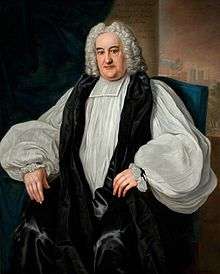John Hoadly
| The Most Reverend John Hoadly | |
|---|---|
| Archbishop of Armagh, Primate of All Ireland | |
 | |
| See | Armagh |
| Installed | 1742 |
| Term ended | 1746 |
| Predecessor | Hugh Boulter |
| Successor | George Stone |
| Other posts |
Bishop of Ferns and Leighlin Archbishop of Dublin |
| Personal details | |
| Born |
27 September 1678 Tottenham, Middlesex |
| Died |
19 July 1746 (aged 67) Rathfarnham |
| Nationality | English |
| Denomination | Church of Ireland |
| Alma mater | St Catharine's College, Cambridge |

John Hoadly (1678–1746) was an Anglican divine in the Church of Ireland. He served as Bishop of Ferns and Leighlin (1727 to 1730), as Archbishop of Dublin (1730 to 1742), and as Archbishop of Armagh from 1742 until his death.
Life
He was born at Tottenham, Middlesex, 27 September 1678, and was younger brother of Benjamin Hoadly. He was a member of St. Catharine's Hall, Cambridge[1] (B.A. 1697), and in September 1700 was appointed under-master of Norwich grammar school, of which his father was head-master. After passing some years there he became chaplain to Bishop Gilbert Burnet, who gave him the rectory of St. Edmund's, Salisbury, and made him successively prebendary (21 February 1705–6), archdeacon (6 November 1710), and chancellor (16 April 1713) of Salisbury. The author of a pamphlet The Salisbury Quarrel Ended of 1710, relating to local conflicts, attributed to Hoadly's influence the High Church party's troubles with Burnet. He was also attacked for his friendship with Thomas Chubb.[2]
In 1717 Lord King, as chief justice of the common pleas, presented Hoadly to the rectory of Ockham, Surrey; and in 1727 he was consecrated bishop of Leighlin and Ferns. William Whiston protested because he thought Hoadly ignorant. In July 1729 a vacancy occurred in the archbishopric of Dublin, Hugh Boulter wrote to Sir Robert Walpole in support; and Hoadly was translated to Dublin in January 1730. As archbishop of Dublin he built the residence of Tallaght at a cost of £2,500.[2]
In October 1742 Hoadly became archbishop of Armagh on Boulter's death, the lord-lieutenant, the Duke of Devonshire, who was at court when the news arrived, telling the king that he could not do without him. As primate he consented to the abolition of restrictions on Roman Catholic services. He was for many years a major force in Irish politics.[2]
Hoadly died at Rathfarnham, 19 July 1746, of a fever.[2]
Works
Hoadly's writings consisted of occasional sermons, a pastoral letter on the rebellion of 1745, a defence of Burnet's work on the articles against William Binckes, 1703, and a commentary on Bishop William Beveridge's writings.[2] In the British Library Catalogue (accessed online 19 November 2012) are: 1. A Defence of the ... Bishop of Sarum in answer to a Book [by W. Binckes,] entituled A Prefatory Discourse to an Examination of the Bishop of Sarum's Exposition of the XXXIX. Articles, etc. London : A. Baldwin, 1703. 2. The abasement of pride: a sermon preach'd in the cathedral of Salisbury, at the assizes held for the county of Wilts, July the 18th. 1708. upon occasion of the late victory. London : printed for Tim. Childe, 1708. Great Britain England London. 3. An Answer to a Letter from a Citizen of New Sarum being a true account of the affront offer'd the Bishop [G. Burnet] there: and a fresh proof of the mallice and injustice of his enemies. [1710]
Family
Hoadly's only daughter, Sarah, married on 29 November 1740 Bellingham Boyle (b. 1709), M.P. for Bandon Bridge, a distant cousin of the Irish Speaker Henry Boyle.[2]
References
- ↑ "Hoadly, John (HDLY678J)". A Cambridge Alumni Database. University of Cambridge.
- 1 2 3 4 5 6
 "Hoadly, John (1678-1746)". Dictionary of National Biography. London: Smith, Elder & Co. 1885–1900.
"Hoadly, John (1678-1746)". Dictionary of National Biography. London: Smith, Elder & Co. 1885–1900.
- Attribution
![]() This article incorporates text from a publication now in the public domain: "Hoadly, John (1678-1746)". Dictionary of National Biography. London: Smith, Elder & Co. 1885–1900.
This article incorporates text from a publication now in the public domain: "Hoadly, John (1678-1746)". Dictionary of National Biography. London: Smith, Elder & Co. 1885–1900.
| Church of Ireland titles | ||
|---|---|---|
| Preceded by Josiah Hort |
Bishop of Ferns and Leighlin 1727–1730 |
Succeeded by Arthur Price |
| Preceded by William King |
Archbishop of Dublin 1730–1742 |
Succeeded by Charles Cobbe |
| Preceded by Hugh Boulter |
Archbishop of Armagh 1742–1746 |
Succeeded by George Stone |
